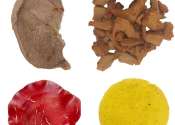Last update:
Other news

Some plant-based steaks and cold cuts are lacking in protein, researchers find
Many plant-based meats have seemingly done the impossible by recreating animal products ranging from beef to seafood. But beyond just the taste and texture, how do these products compare to the real thing in nutritional value? ...
Biochemistry
Apr 19, 2024
0
128

Video: Is there a quick fix for ocean acidification?
Acidification is threatening the ocean's ability to pull carbon dioxide out of our atmosphere, so scientists and startups are looking to ocean-sized antacids to raise its pH.
Other
Apr 15, 2024
0
3

The flavors of fire: How does heat make food taste good?
Sure, cooking our food can make it safer to eat and more digestible. But let's be honest. We mainly cook to create something we enjoy—something delicious.
Biochemistry
Apr 8, 2024
0
8

Computational chemistry needs to be sustainable too, say researchers
A diverse group of computational chemists is encouraging the research community to embrace a sustainable software ecosystem. That's the message behind a perspective article published in the Journal of Chemical Theory and ...
Analytical Chemistry
Apr 4, 2024
0
49

Video: Using chemistry and a 300-year-old technique to reinvent a drink
Adding milk to an alcoholic drink and then curdling that milk is a 300-year-old preservation technique that was used by none other than Ben Franklin.
Other
Apr 3, 2024
0
20

What washing machine settings can I use to make my clothes last longer?
Orbiting 400 kilometers above Earth's surface, the astronauts on the International Space Station live a pretty normal social life, if not for one thing: they happily wear their unwashed clothes for days and weeks at a time. ...
Other
Mar 16, 2024
1
16

Vinegar and baking soda: A cleaning hack or just a bunch of fizz?
Vinegar and baking soda are staples in the kitchen. Many of us have combined them in childhood scientific experiments: think fizzy volcanoes and geysers.
Analytical Chemistry
Mar 14, 2024
0
1

Video: Complex chemistry in the cold depths of space
For years, scientists thought some complex molecules could only be formed on Earth.
Other
Mar 12, 2024
0
4

Scientists develop new machine learning method for modeling chemical reactions
Researchers from Carnegie Mellon University and Los Alamos National Laboratory have used machine learning to create a model that can simulate reactive processes in a diverse set of organic materials and conditions.
Analytical Chemistry
Mar 7, 2024
0
88

Using metabolomics for assessing safety of chemicals may reduce the use of lab rats
Scientists have discovered a more robust way of grouping chemicals and using read-across for toxicological data to meet regulatory requirements, which could greatly reduce animal testing.
Materials Science
Feb 20, 2024
0
7

Exploring the chemistry behind love this Valentine's Day
Chemistry in a relationship refers to the intense feelings of connection, passion, and romance that people share. This Valentine's Day, Dr. Alex Baker, a chemistry professor at the University of Warwick, explores the real ...
Other
Feb 13, 2024
0
1

Video: Are ammonia engines the way of the future?
Could ammonia engines power the cars of the future? Carmakers like Toyota are working to make this a reality.
Other
Feb 13, 2024
0
11

What is micellar water and how does it work?
Micellar water, a product found in supermarkets, chemists and bathroom cabinets around the world, is commonly used to remove make-up. It's a very effective cleanser and many people swear by it as part of their skincare routine.
Materials Science
Feb 11, 2024
0
1

Video: Can science beat counterfeit detector pens?
Counterfeit detector pens use a starch-iodine reaction to identify fake bills.
Other
Jan 29, 2024
0
1

Helium is essential for research, medical equipment, but it's nonrenewable and difficult to recycle
The next time you pick up balloons for your big party, remember the helium gas in those balloons is destined for the stars. Helium is so light that it easily escapes Earth's gravity, and all helium will eventually make its ...
Other
Jan 18, 2024
0
8

New crystalline sponge method proposed for undergraduate courses
The crystal sponge technology is a revolutionary technique, which enables the direct and precise determination of the molecular structure of liquid and gas targets. The technique uses a special network complex to selectively ...
Analytical Chemistry
Jan 2, 2024
0
2

Nonalcoholic beer: New techniques craft flavorful brews without the buzz
The holiday season for me includes socializing over drinks with friends and family. But all the celebrating tends to catch up with my waistline, and by New Year's Day, it's time to get back in shape. Besides vowing to hit ...
Other
Dec 13, 2023
0
2

Thank gluten's complex chemistry for your light, fluffy baked goods
Within the bread, rolls and baked goods on many tables this holiday season is an extraordinary substance—gluten. Gluten's unique chemistry makes foods airy and stretchy.
Other
Nov 21, 2023
0
19

How is decaf coffee made? And is it really caffeine-free?
Coffee is one of the most popular drinks in the world, and its high levels of caffeine are among the main reasons why. It's a natural stimulant that provides an energy buzz, and we just can't get enough.
Analytical Chemistry
Nov 1, 2023
0
2

Study shows forensic evidence can survive underwater for weeks
Forensic fibers can survive underwater for much longer than previously thought—which could help criminal investigators uncover vital evidence.
Analytical Chemistry
Oct 16, 2023
0
66
More news

Researchers create 3D-printed vegan seafood

Animal testing under REACH: Bringing numbers into the debate

Video: What is meat?
Other news

Managing meandering waterways in a changing world

How much trust do people have in different types of scientists?

Freeze casting—a guide to creating hierarchically structured materials

Advanced cell atlas opens new doors in biomedical research

What do the elements sound like?

How diluting ouzo liquor could lead to better emulsions

Airborne single-photon lidar system achieves high-resolution 3D imaging



























































